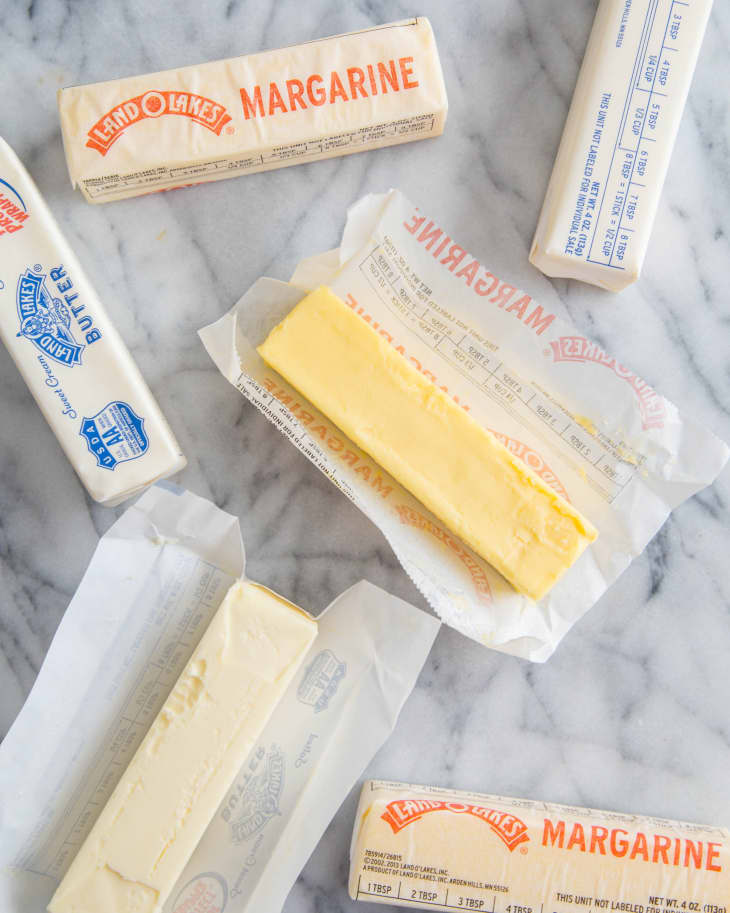What’s the Difference Between Butter and Margarine?
Take a walk down the dairy aisle and you’ll notice an ever-growing selection of butter and margarine. Most people have strong opinions about which one they prefer.
But do you really know the difference between butter and margarine?
The Difference Between Butter and Margarine
While used for many of the same purposes, butter and margarine are two very different products. The primary factor that sets them apart is what they’re made from, and thus the types of fats they contain.
What Is Butter?
Butter is the dairy product made from churning milk or cream. The churning process separates the butterfat (the solids) from the buttermilk (the liquid). The butter we most often buy is made from cow’s milk, although other varieties — made from the milk of sheep, goat, yak, or buffalo — are also available.
While typically pale yellow in color, butter can range from white to deep yellow, depending on the animal’s diet. And since, at its core, butter is made from one ingredient, it can be made at home.
You may have noticed your butter labeled as “sweet cream butter.” This indicates that the cream used to make the butter went through
the pasteurization process
Whipped butter, designed to be more spreadable, adds air into the butter, making it lighter and less dense. So an equal-sized portion of whipped butter, as compared to regular butter, has fewer calories and a lower fat content.
The biggest factor that sets different brands of butter apart is the fat content, which ultimately has an effect on the butter’s taste and texture. All commercially sold butter in the U.S. must be at least 80 percent fat. As butter is an animal fat, it contains cholesterol and is higher in saturated fat than margarine.
What Is Margarine?
Now that we know what butter is, so exactly
what is margarine
It’s important to know that not all margarine is created equal. There are variations from brand to brand, so it’s important to read the label. Unlike butter, margarine isn’t something that can be made at home.
Like butter, regular margarine must also have a minimum fat content of 80 percent by law. Anything less is considered a “spread.” The margarine and spreads found in the dairy aisle can range from 10 to 90 percent fat. Depending on the fat content, the levels of vegetable oil and water will vary, with those containing a lower fat content having a higher percentage of water.
Since margarine’s primary component is vegetable oil, it lacks the cholesterol and saturated fat found in butter, and has a higher percentage of polyunsaturated and monounsaturated fats. It may, however, contain trans fat — although, many brands have reduced or totally eliminated this from the ingredient lineup, using palm oil and palm kernel oil in its place.
Which Is Better? Butter or Margarine?
If you’ve tasted each of these spreads, then you know just how vastly different they are. Growing up in the early ’80s, we were a margarine household for quite a long time. Thankfully at some point we made the switch to butter. Once I tasted really good butter, it was like a light came on and I knew this was the stuff I needed to be eating. Good-quality butter tastes amazing — there’s just no way around it.
The type of fat found in butter and margarine is a defining factor in what sets them apart. While butter is derived from animal fat, margarine is made with vegetable oil. This difference has an impact on taste, texture, and nutrition.
As far as substituting one for the other, it’s best to go by the recipe, especially when it comes to baking. Those margarines that have a lower fat content contain more water, which can lead to tougher baked goods.
As far as which one is better, your best bet is to just use whichever one you choose in moderation.
